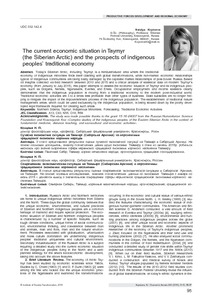The current economic situation in Taymyr (the Siberian Arctic) and the prospects of indigenous peoples’ traditional economy
Скачать файл:
URI (для ссылок/цитирований):
https://elib.sfu-kras.ru/handle/2311/33043Автор:
Копцева, Н. П.
Коллективный автор:
Гуманитарный институт
Кафедра культурологии
Дата:
2015-11Журнал:
Economic Annals-XXIКвартиль журнала в Scopus:
Q2Библиографическое описание:
Копцева, Н. П. The current economic situation in Taymyr (the Siberian Arctic) and the prospects of indigenous peoples’ traditional economy [Текст] / Н. П. Копцева // Economic Annals-XXI. — 2015. — 9-10. — С. 95-97Текст статьи не публикуется в открытом доступе в соответствии с политикой журнала.
Аннотация:
Today’s Siberian Arctic, including Taymyr, is a reindustrialized area where the traditional economy of indigenous minorities finds itself clashing with global transformations, while non-market economic relationships typical of indigenous communities are being badly damaged by the capitalist market relationships of post-Soviet Russia. Based on insights collected via field research between 2010 and 2015 and a critical analysis of statistical data on modern Taymyr’s economy (from January to July 2015), this paper attempts to assess the economic situation of Taymyr and its indigenous peoples, such as Dolgans, Nenets, Nganasans, Evenks, and Enets. Occupational employment and income statistics clearly demonstrate that the indigenous population is moving from a traditional economy to the modern post-industrial world. Traditional economic activities are 3 to 4 times less profitable than other types of business. State subsidies are no longer helping to mitigate the impact of the impoverishment process of the indigenous population. The establishment of traditional nature management areas, which could be used exclusively by the indigenous population, is being slowed down by the poorly developed legal framework required for creating such areas.

